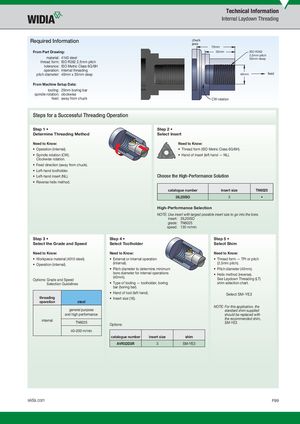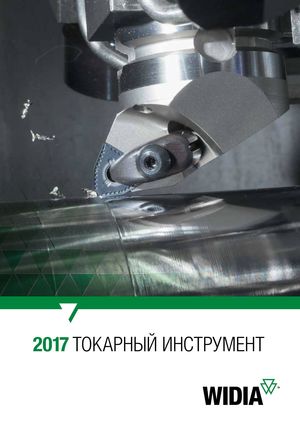Общий каталог Widia 2017 - страница 697
Навигация
- Table of Contents
- Turning
- Turning • ISO Inserts
- Turning • Tools for External Turning and Internal Boring
- Turning • Tools for External Turning and Internal Boring
- Turning • Tools for Small Hole Boring
- com E1Turning • Grooving and Cut-Off
- Turning • Threading
- Indexable Milling
- Indexable Milling • Face Mills
- Indexable Milling • Chamfer Mills
- Indexable Milling • 90° Shoulder Mills
- Indexable Milling • Helical Mills
- Indexable Milling • Slotting Mills
- Indexable Milling • Copy Mills
- Solid End Milling
- Solid End Milling • High-Performance Solid Carbide End Mills
- Solid End Milling • General Purpose Solid Carbide End Mills
- Solid End Milling • High-Performance High-Speed Steel (HSS-E/PM)
- Solid End Milling • Burs
- Holemaking
- Holemaking • High-Performance Solid Carbide Drills
- Holemaking • Modular Drills
- Holemaking • Indexable Drills
- Holemaking • Modular Drills
- Holemaking • Indexable Drills
- Holemaking • Hole Finishing
- Tapping
- Tapping Portfolio
- Index by Order Number
- Index by Catalogue Number
- Global Contacts
- Informational Icons Guide
- Material Overview • DIN

Technical Information Internal Laydown Threading Required Information chuckjaws 70mm From Part Drawing: 35mm ISO R262 2,5mm pitch material: 4140 steel 50mm deep thread form: ISO R262 2,5mm pitch tolerance: ISO Metric Class 6G/6H operation: internal threading pitch diameter: 40mm x 35mm deep 40mm feed From Machine Setup Data: tooling: 20mm boring bar spindle rotation: clockwise feed: away from chuck CW rotation Steps for a Successful Threading Operation Step 1 • Step 2 • Determine Threading Method Select Insert Need to Know: Need to Know: • Operation (internal). • Thread form (ISO Metric Class 6G/6H). • Spindle rotation (CW). • Hand of insert (left hand — NL). Clockwise rotation. • Feed direction (away from chuck). • Left-hand toolholder. • Left-hand insert (NL). Choose the High-Performance Solution • Reverse helix method. catalogue number insert size TN6025 3IL25ISO 3 • High-Performance Selection NOTE: Use insert with largest possible insert size to go into the bore. insert: 3IL25ISO grade: TN6025 speed: 130 m/min Step 3 • Step 4 • Step 5 • Select the Grade and Speed Select Toolholder Select Shim Need to Know: Need to Know: Need to Know: • Workpiece material (4010 steel). • External or internal operation • Thread form — TPI or pitch • Operation (internal). (internal). (2,5mm pitch). • Pitch diameter to determine minimum • Pitch diameter (40mm). bore diameter for internal operations • Helix method (reverse). (40mm).Options: Grade and Speed See Laydown Threading (LT) Selection Guidelines • Type of tooling — toolholder, boring shim selection chart. bar (boring bar). • Hand of tool (left hand). Select SM-YE3 threading • Insert size (16). operation steel NOTE: For this application, the general purpose standard shim supplied and high performance should be replaced with internal TN6025 Options: the recommended shim,SM-YE3. 40–200 m/min catalogue number insert size shim AVR32D3R 3 SM-YE3 widia.com F99
 Каталог Widia токарный инструмент 2017
Каталог Widia токарный инструмент 2017 Каталог Widia трохоидальное фрезерование
Каталог Widia трохоидальное фрезерование Каталог Widia техническое руководство по разверткам
Каталог Widia техническое руководство по разверткам Каталог Widia фрезы со сменными пластинами 2016
Каталог Widia фрезы со сменными пластинами 2016 Каталог Widia достижения 2020
Каталог Widia достижения 2020